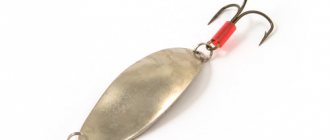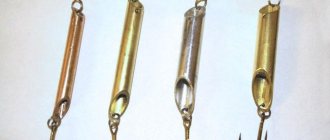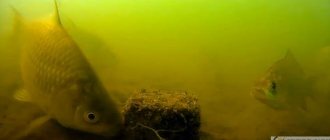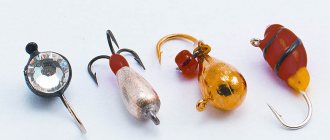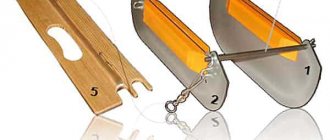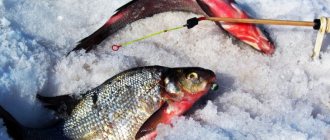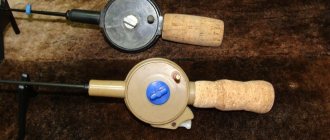One of the popular methods of baitless (reelless) fishing in winter is the method of fishing with a “devil” (hereinafter without quotes, so as not to clog the air) - a jig with a vertical suspension.
Devil (devil) is a nozzle-less jig for vertical suspension with 3-4 hooks bristling in all directions. The shape may vary from teardrop-shaped to elongated pot-bellied. The first thorough mentions in Russian literature date back to the early 70s. That is, this type of winter fishing has been around for almost half a century... The two-hook model of a devil-type jig is called a goat and is not so popular.
Features of the jig, advantages and disadvantages of nozzle
The devil especially manifests himself during the dead of winter, when balancers, bulldozers and spinners are silent. It is worth noting that the mothless devil resembles the food supply of peaceful and predatory fish - insects.
At the same time, there is an opinion, and not unfounded, that devils also simply serve as irritants for pressed fish. This is especially evident in cases where the fish does not respond to baited jigs or a float rod. What is typical is that in overfed reservoirs, it is the mothless moth that often shows its best qualities - is this not evidence of a double blow to the instincts of underwater inhabitants?
Another advantage is the almost perfect hookability, due to the multi-directional hooks around the jig. Any angle of attack of a fish on an imp is doomed to result.
The disadvantages include the other side of the coin - in some situations, reelless fishing is inferior to fishing with live bait. But it’s like this everywhere in life, somewhere we find it, somewhere we lose it.
It is also worth noting this point - due to the fact that there are a large number of varieties of devils, and there are not so many catchy models, it is difficult to choose the right one, especially for a beginner. But if the arsenal is already assembled... It will be universal and suitable for any conditions. You just have to correctly select all the keys to success: “choosing a reservoir and fishing location, choosing the right weather, choosing bait, collecting gear, supplying bait.”
Who goes to hell in winter?
The devil can be used to catch both peaceful and predatory fish, which is also an advantage of the devil.
Main clients:
- perch;
- chub;
- ide;
- roach;
- perched water;
- bream, white bream;
- ruff.
The perch will not pass by...
And they also successfully catch crucian carp using the devil:
What is a devil?
A devil is an elongated jig with a small soldered or hanging tee at the bottom, designed for vertical play. Various forms and modifications of this bait have been developed. The prototype of such a jig in the 60s of the last century was the sea bait “bug” by V. Zakharov from Magadan. Since then, devils have become a separate area of winter fishing. Some sources claim that this jig resembles the amphipod crustacean in shape and movements in the water, which is why this bait attracts fish so well.
Despite the apparent simplicity of fishing with this tackle, beginners do not always manage to successfully master it right away. This happens due to the initial lack of important details in the tactics:
- Fishing with a devil requires fine adjustment of the nod to the weight of the bait.
- In your arsenal you need to have a set of pre-configured and equipped fishing rods with different shapes and weights.
- When fishing, bait options are used (on already prepared fishing rods) until a worker under these conditions is found.
- The proverb “the legs feed the wolf” is just right for winter fishing with a no-attachment devil jig.
- You need to master several ways of playing perfectly. Often bites occur precisely during a pause or during a sudden change in the game or the pace of the retrieve.
This article outlines how to fish for devil in winter, choose the right bait and set up your fishing rods. Some secrets and nuances of such fishing are considered.
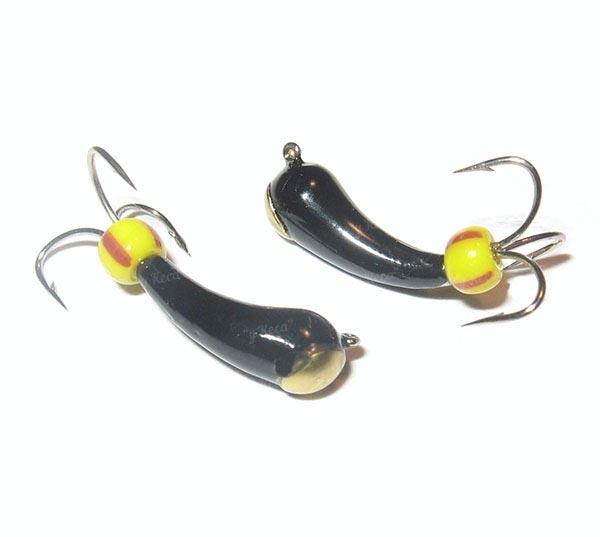
How to choose a catchy devil
There will be no ratings here. It is more important to choose the necessary reelless reel for specific fishing conditions. The same model will show better results in some conditions, and worse in others. In the second jig, on the contrary.
Also, catchability directly depends on whether the angler has found a common language with this or that bait. What will fall into someone's hand?
You need to experiment and have a set in your arsenal for a variety of conditions. Let's go through the main categories of devils.
Classic - hard-soldered tee, or three single hooks
The main species that is an apologist in devil fishing. The body shape is very different - drop, olive, cone, trapezoid, “ant”, etc. It's good to have different shapes, weights and materials in the box.
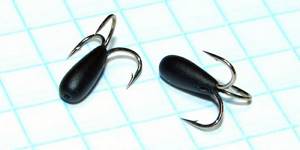
Rewinder with free tees
Another variety is devils with loose hooks. On the one hand, this gives a more attractive game, but also a more chaotic one. Therefore, the choice of a rigidly or loosely fixed anchor must be made based on the conditions.
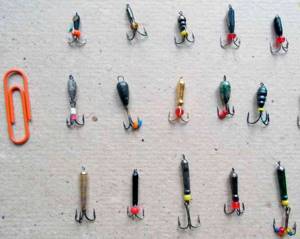
Varieties of devils - jellyfish, goats and more
Jellyfish is a type of devil with hooks around the body, which are secured with a wire ring:
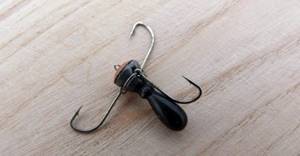
A goat is a rewinder on two hooks:
Killer devils and their testing on the water:
There are a large number of species and subspecies of devils. Different shapes and sizes, different designs, weights, materials. The selection of catchy little devils has been going on for years until a universal set has been compiled, which will contain your favorite reelless jigs for different fishing conditions.
It should be understood that this type of bait is made by a huge number of both stream manufacturers and craftsmen. Therefore, it is not possible to designate the notorious TOP 10 of the best catchy little devils.
Making your own bait
There are several ways to make devils yourself: from simple to complex.
In order to make a homemade bait with your own hands, you need to do the following steps:
- Take a ready-made lead weight with a silicone tube inside.
- The tube is removed.
- Take a tee with a long forend.
- The eye of the tee is flattened with pliers.
- The forend of the tee is threaded through the hole of the sinker.
- The sinker is crimped with pliers.
- The surface of the devil is processed with a file and a needle file.
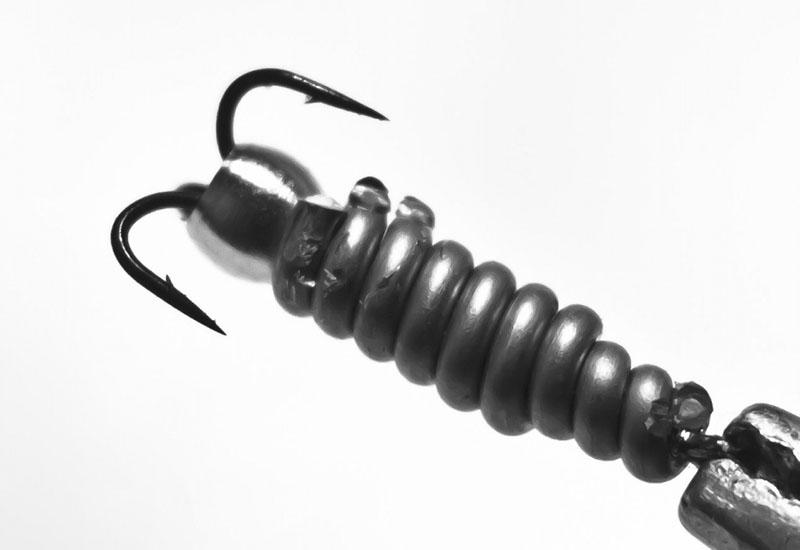
Another simple method involves using copper wire. It looks like this:
- Several turns of copper wire are wound around the forend of the tee.
- The wire is soldered.
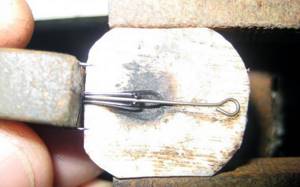
A more complex method involves casting. To make the mold, gypsum, sometimes bread crumb or raw potatoes are used. However, if you do not have to manufacture baits on an industrial scale, you can do without a mold. For this you will need:
Materials:
- wooden block;
- foil;
- three single hooks with a long shank;
- tin or lead.
Tools:
- knife;
- soldering iron;
- container for melting metal;
- file;
- needle file
The process of making a devil consists of the following stages:
- Three slots are made in the wooden block for the hooks.
- The eye of two hooks is bitten off.
- The hooks are inserted into the slots.
- Make a funnel out of foil and place its narrow end on the hooks.
- Pour molten metal into the funnel.
- After the workpiece has cooled, it is processed with a file and a needle file.
- If necessary, paint the bait.
When making devils with a through hole, it is better to pour them into a mold.
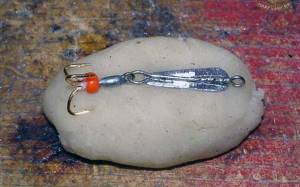
In addition to the hooks, a pin is inserted into the mold, which is pulled out after the workpiece has cooled. The required hole is obtained.

Expert opinion
Knipovich Nikolai Mikhailovich
Zoologist, hydrobiologist. I am interested in fishing at a professional level.
Important! When working with lead, safety regulations must be followed. Metal should be melted under a hood or in a respirator, since lead fumes are poisonous.
How to make a devil jig with your own hands - we invent, prepare, cast
There are a lot of options for making mothballs with your own hands.
The base/body can be made of sheet lead, wire, pellets and other available materials.
The hooks used are either tees or single hooks, depending on the technology.
As an additional point of attack, you can put beads or cambrics on the tees.
To give the body shape and its beauty, epoxy glue, resin, and gel polish can be used.
Loops, when making devils with your own hands, can and should be made in different shapes and bent at different angles to the body of the jig. This will help diversify the game and give additional opportunities to the fisherman when animating the jig.
It's better to see once
How to make a devil jig with your own hands:
How to make devils for winter fishing for fishing with a garland:
Another option:
Fishing for devils in winter
An experienced fisherman knows that jig fishing is active. You can't sit in one place here. You have to unwind and rewind the line often, so for convenience, use a reel with a lever brake. The suitable length of the fishing rod is 40-45 cm, which allows you to hook the fish with a weak bite with a slightly noticeable movement of the wrist. With such a fishing rod, wiring can be done without getting up from the box.
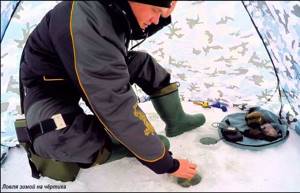
For fishing with devils, use a fishing line with a diameter of 0.08 to 0.12 mm. The nod should be 15 to 20 cm long, which ensures stable play. When there is wind at depth, the nod must be shortened, and in shallow water extended to its full length - only in this position is it capable of constant vibrations that attract fish.
Elements that people pay attention to when choosing a “devil”:
- weight not less than 1 g;
- color black, brown, dark green;
- drop-shaped shape 10-20 mm long;
- the hooks should be directed in different directions.
There are many knots for attaching jigs to fishing line. Popular among anglers is the Clinch.
Selecting a location
A good time for jig fishing is the first ice. The fish continues to fatten before severe frosts. There is still enough oxygen in the water, so the activity of the fish is high.
When choosing a location for holes, make a general assessment of the reservoir. Look for backwaters, areas without current, and places where reeds grow. Roaches especially like to look for their food among plant stems.
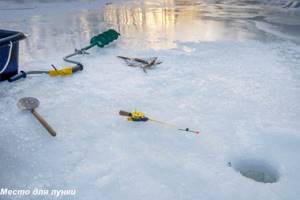
By mid-winter, the amount of oxygen decreases and the fish look for deep places. At this time, it should be looked for in holes and depth changes.
At the end of winter, the fish return to the places where they were on the first ice.
How to catch devils in winter: techniques and tips
The holes are drilled in the standard way. Promising places are selected and holes are drilled in a checkerboard pattern every 8-12 meters. First drill up to 15-20 holes. Fishing begins from the first hole, which has already rested.
If the fishing point is chosen correctly, then there are three components of success - the correctly chosen devil, the correctly configured tackle and the presentation (read wiring) of the reelless reel. This section is about wiring and secrets. Wiring a reelless jig is more important than a jig edged with yummy food in the form of bloodworms and other live bait. This is understandable - the bloodworm praises itself.
Before going to the reservoir and on the reservoir itself, you should pay attention to the following factors that in one way or another affect the quality of fishing and the final success:
- Atmosphere pressure;
- precipitation or lack thereof;
- water and air temperature;
- Direction of the wind;
- ice - thickness, transparency;
- bottom - composition, clutter;
- what insects are present in the pond - a direct indication of which devil to choose;
- correctly selected tackle;
- selection of the required devil and approach to its animation.
Basic postings
There is not and cannot be a single correct wiring for the devil. In different conditions (body of water, type of fish, depth, atmospheric conditions, etc.) different types of animation will be good. But the prompt selection of that same recipe for specific fishing conditions is the basis of success, the basis of which is the experience of the fisherman.
Also, do not forget that the style of animation of the bait, as well as the bait itself, should fit, as they say, “into the hand”, be consistent with the character of the fisherman, his vision of fishing as a whole.
Practical fact. A fisherman, albeit less experienced, but who has thoroughly studied a particular body of water and the habits of its inhabitants, will always catch a more experienced “devil fisher”, but who has found himself in new conditions for the first time. There is no point in catching perch where there is raft or bream, be it a spoon or a devil.
But it wouldn’t be superfluous to study the basics of animating mothless creatures (why reinvent the wheel in the 21st century), especially for novice imps.
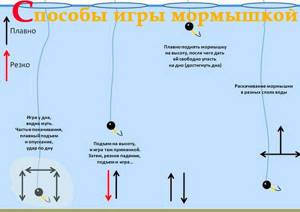
Jig animation options
Standard - classic step
The most common wiring among others. Its advantage is its versatility and working qualities for a variety of fish.
The imp descends to the bottom of the hole, a pause is given until the nod is played to a strictly horizontal position. The overhang of the fishing line is noticeable. Then, with progressive movements, the rewinder rises to the surface in steps. This is clearly noticeable by the nod - the devil seems to move from step to step with smooth movements of the fishing rod.
The step size between steps can vary from 1-2 cm to 10-15 cm. It all depends on how aggressive the wiring is needed. Let's say that slow dribbling is good for perch; the more chaotic, the better. And the roach prefers short steps of 5-7 cm with pauses.
Pauses between throwing the jig from step to step can vary from practically non-existent to quite significant, up to 5-10 seconds or more. The more active the fish, the shorter the pause - in general, this is exactly the animation that works.
The pace of the devil's rise also differs from lazy, imposing for bream and crucian carp, to fast tracking for perch and pike perch.
You can add elements of dribbling to the wiring - constant twitching of the rewinder throughout the execution of the steps. It is especially effective to catch perch with a devil using this type of fishing.
The height of the entire ladder is selected empirically and depends on the horizon in which the fish is standing. At the beginning and end of winter, you need to break through the entire horizon; often peaceful fish graze in the water floor and you should not limit yourself to the bottom layer of the reservoir. But in the middle of nowhere, most often you should look for fish at the bottom and half a meter or meter from it. In any case, initially you need to look for fish along the entire vertical and only having found it, then do the active phase of wiring in the working fish horizon.
Spruce-shaped wiring
“Christmas tree” is one of the variants of stepped wiring, in which the movements of the fishing rod are not made strictly vertically, but to the sides, as if cutting the characteristic teeth of a drawn Christmas tree in multidirectional waves. All other components echo the stepped wiring. More often, such wiring is used when attaching a bloodworm to a jig, but it is also used in a reelless bait. Devil catchers use this animation on perch.
The fishing rod is held at a certain angle downward to the horizon of 30-45 degrees.
Dribbling in a given perspective horizon
If using the “herringbone” or “step” the working horizon of the fish’s position is determined, then you can fish only it within 30-50 cm, having previously marked it with a cambric on the fishing line, or by noticing it using the length of the overhang.
Wiring consists of shaking with varying amplitude using short pulls with a fishing rod. Some fishermen set up this game by small and quick tapping of the fishing rod with their left hand, while the vertical movement of the jig is set with their right hand.
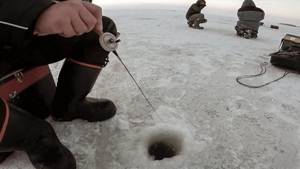
Teasing element - as an option for deep winter and difficult conditions
In the case when the fish is passive and presses to the bottom, you can use the devil's pulls along the bottom, almost without leaving it. All wiring occurs in a horizontal plane, and the nod bends and unbends, slowly trembling.
The little devil is a jumper
The reelless machine sinks to the bottom, after which the fisherman taps the bottom with targeted blasts and further recoil of the fishing line. Thus, the devil simply actively jumps along the bottom, raising a small cloud of turbidity. A very good option for active fish and as an intermediate type of animation if the fish does not respond to the main movements.
Lazy, uniform stretches and descents
Slow stretches without jerking with a pause at the final dead center, after which the devil begins to crumble, are used when catching bream and bream, large roach, rudd and other cautious peaceful fish.
It is important that the detachment of the reelless jig from the bottom is as smooth and uniform as possible without parasitic vibrations of the jig on the rise.
Index finger animation
In this case, the rod is held with the palm of your hand so that the index finger lies on top of the whip. The wiring is carried out vertically evenly, and the rattling is set by striking the whip with a finger. The blows can occur throughout the entire wiring, and at certain moments - during pauses, rise, fall of the devil.
Let's combine!
In any incomprehensible situation, we experiment with combinations of different methods of delivering a rewinder. Correctly selected wiring is the key to success. It is important to change the speed of the animation, the sharpness of the stretches, the amplitude and frequency of the trembling, the height of the steps on the stepped wiring, the size and length of the pauses.
It is also very important to look for fish in different horizons. We punch in segments (bottom-20 cm), (20 cm - 50 cm from the bottom), (50 cm - a meter above the bottom).
Worth knowing! What should you do if the fish stops responding to the bait in the hole where it just bit? It is worth noting that after a long variety of different types of fishing in one hole, the fish may “get tired” and stop responding to even the most delicious presentation of the devil. In such a situation, you should either let the hole rest, or put the jig on the bottom and give it a pause without moving the bait slightly, or with minimal movement.
In general, it is worth noting that you should not “torment” one hole for a long time. A dozen or one and a half different types of devil animation in one hole, it’s worth moving to the next, pre-prepared hole.
Video on the topic of fishing for devils in the dead of winter - a master class from a professional:
Bream fishing
The devil sinks to the bottom in a promising “bream” place with a nod when the reeler hits the bottom. Since bream often does not stand at the very bottom, but at some distance from it or even in the water column, a long vertical retrieve with a gentle herringbone animation down to half the water would be promising.
Bream loves slow, imposing movements of the devil, especially controlled returns.
It is also worth using pauses and quite long ones when performing stepwise wiring.
Devils with freely suspended hooks on the slowest retrieves near the bottom are good for bream.
Catching bream with a devil:
Bream can be caught at night, which suggests that the behavior of the bream is more important than its appearance. And the behavior directly depends on the angler’s ability to animate the little demon correctly (from the fish’s point of view).
It is worth noting that when fishing for devils, especially bream, the hook should be quite fast, but not long, otherwise you can break thin tackle or a delicate lip. Both options, as you might guess, are not the best option.
Perch fishing
Perch prefers a fairly fast rattle of the devil, combined with an average speed of the bait rising to the surface. Stripes rarely respond to sluggish play; more often give them sharp and chaotic jerks.
Among the colors he prefers black and yellow.
Catching roach, ide and chub
This trio of fish prefers smoother movements. Among the workers - a slow and medium step at the bottom and half-water, a herringbone without sudden jerks.
An animation of this type is also good - the devil rises by steps by 40-60 centimeters. Then it lowers in a controlled manner by 20 centimeters and makes 3-4 light jerks, then lowers another 20 cm and more jerks, and so on until the very bottom. Then the steps are repeated.
Winter fishing for large roach using the Prick line:
Fishing for pike perch
Pike perch prefers large reelless baits and fishing near the bottom. A step, a Christmas tree, various combined animations with pauses of rises and falls.
Fishing for crucian carp
When catching crucian carp with a reelless bait, you should prefer wiring options that can be executed in the water column.

Types of devils
When fishing for devils in winter, various versions of these jigs are used. At first glance, it seems that there are a lot of species, and they are very different. In stores you can find bimetallic soldered devils or single-color lead ones, solid and composite, large and very small. Craftsmen produce an even larger assortment. But the basic principle is the same - the bait is a kind of mass core (the body of the jig) and a tee hook at the bottom. The differences appear in the details, but they are the ones that influence the fish’s favorability towards the bait at a particular moment in the fishing conditions.
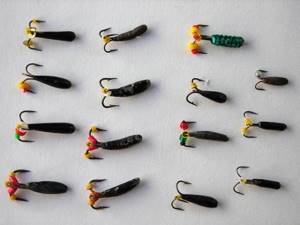
Form
Devils for winter fishing differ in the shape of the body of the jig. There are three large groups:
- Elongated (columns, sticks, cones);
- Short (droplets, balls, pot-bellied);
- Relief (ants, nymphs, etc.)
These baits are made in large or small sizes, of different weights, straight or bent, solid or with a non-ferrous metal plate. Large ones are used for catching pike perch at great depths; they weigh up to tens of grams, and are more likely to be winter lures than jigs. The body of the devil can be one-piece or two-part. Composite ones provide a kind of wiring. Some look like micro-spinners.
The classic fishing feature is cone-shaped, thickened and rounded at the top. The jig can be painted in various colors. Black or lead (no color) is considered a classic. White, red or other colors are less commonly used. Differences in shape give different play.
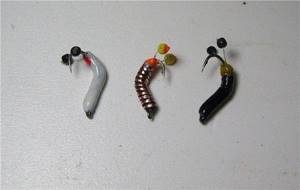
Bent devils
Tying to a fishing line
According to experienced devil hunters, the correct binding is in a vertical hole through the body using a hook. These are the devils of the famous expert on them, Andrei Kalachev. Occasionally, such baits are found in stores. More often they are made independently or to order. This connection gives the correct game. Kalachev’s little devil, in the opinion of many, is the most catchy and “correct”; when used skillfully and under the right fishing circumstances, it “mows down” the fish from the hole.
Standard methods of tying are by a ring or through a horizontal hole in the case (as in ordinary jigs). Some baits with a jig-type tying method provide suspension at an angle to the vertical, which gives a special, nodding game.
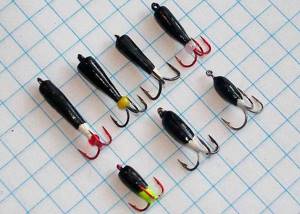
With a ring
Hook attachment
The three-pieces on the devils are often firmly sealed into the body of the bait. This is the standard option. Less common are models with a hanging hook, which make additional movements when retrieving (devils). There are models with several single hooks, each of which is loosely attached to the body. These are jellyfish (or witches). The bait, which is something between the devil and the uralka - goat, has two hooks soldered into the body.

With soldered tees
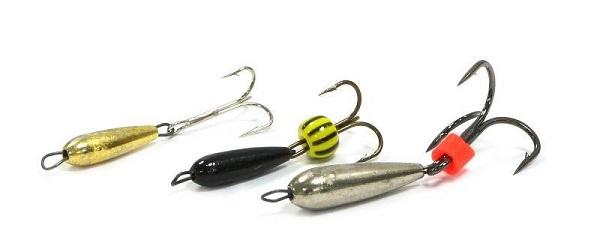
With hanging tee (demon)
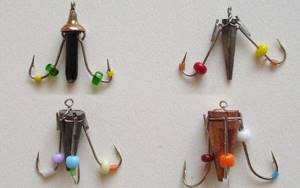
Medusa (bastard, witch)
Decorations
The most important part of the feature is that the various colorful devices on the hooks, which directly affect the interest and irritation of the fish, are the point of attack. These are various balls, cambrics, beads, threads, etc. Common colors used are white, red, yellow, orange and dark green. An interesting nuance that often brings bites is the placement of the bead above the bait freely on the fishing line. When playing, it moves, attracts fish with its color and tapping on the body of the jig. It is impossible to say unequivocally which color works best for a particular fish - this is a matter of experimentation during fishing. But I often find information on the Internet that white and dark green beads work well for roach, and red and yellow beads for perch. At great depths and at night, drops of phosphorus varnish on a tee work well.
Experienced fishermen have a whole arsenal of different features and fishing rods pre-configured for them. Beginners are recommended to start with standard solid jigs, having several black and lead models of different weights with different colored decorations (accordingly, already fully configured tackle, so as not to have to do this on the pond). During the fishing process, you need to go through the same holes with different equipment, changing the fishing methods, until the most catchy bunch is identified.
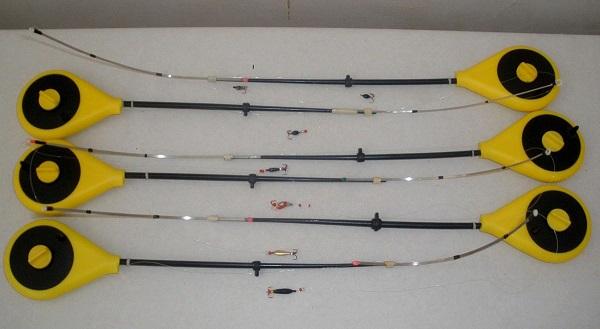
A set of customized fishing rods for different weights and nods
Collecting tackle
Balalaika is the most popular fishing rod when fishing with reelless jigs. It is light, fits well in the hand and is very sensitive. It is these qualities that allow you to perform various animations throughout the day comfortably and efficiently.
The fishing rod must have a reel and be light in weight—that’s exactly what the balalaika is about.
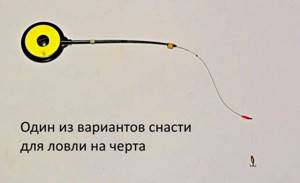
Balalaika fishing rod
The whip must be as sensitive as possible in order to successfully work with the smallest weights of mothless fish. Carbon is the preferred material.
The nod must match the tackle. It must be conical, tapering towards the tip and of sufficient length up to 15-22 cm. This length allows you to work as tightly as possible with the smallest imps. Materials: lavsan, spring.
Varieties of nods that work with devils:
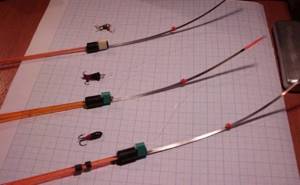
Nod to bream
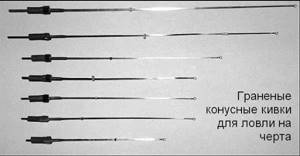
Cone nods
A nod to the reelless devil “Spring”:
The fishing line is selected depending on the depth at the fishing spot, the expected trophies and the weight of the devil. The standard is 0.1-0.14 mm, no thicker. Otherwise, you won’t be able to play well and feel the small jigs.
How to tie a reelless jig: devil, goat, carnation and others
The simplest and most standard option for tying a devil to a fishing line:
Detailed guide on tying jigs:
As some experienced people advise, one of the good options for tying a devil to a fishing line is a figure eight knot, but with a nuance. Until the knot is completely tightened, wet it and use a toothpick to form a small loop near the eyelet of the devil. This gives additional freedom when playing and supposedly increases catchability.
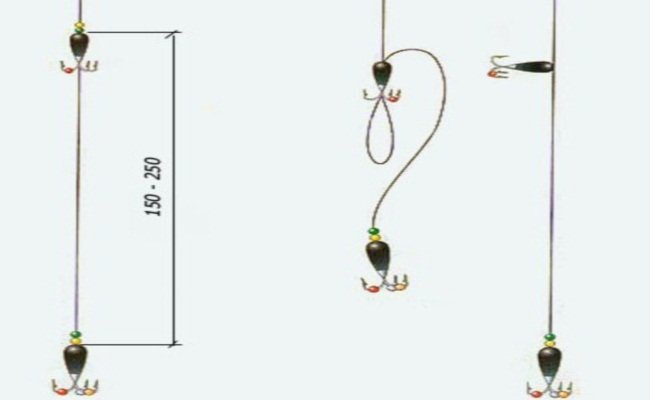
Two devils on one line
With the right gear, the right fishing location and animation method, fishing with the devil allows you to get away from zero in the most difficult conditions on pressed-in reservoirs.
Tackle device for the “devil”
There are three conditions for it:
- Sensitivity to bites. This is ensured by the softness (relative, of course) of the nod.
- The ability to generate smooth, mid- and low-frequency vibrations. Again - provided by a nod, but this time - its length.
- Possibility of winning a large trophy. It is ensured by the strength, elasticity and flexibility of the fishing rod, the presence of a reel with a friction clutch and the appropriate thickness of the fishing line.
If you comply with only the first two of them, you can already go fishing. Everything will work out with the game, although the risk of losing the bait increases noticeably. Therefore, it is better not to save on a fishing rod. Perhaps it is worth taking a closer look at its options.
Rods for fishing with devils
This can be either a purchased or a handicraft product. The main thing is that the fishing rod lies very ergonomically in the palm of your hand and is light - so that the fisherman can play without straining. Well, of course, it should absorb strong jerks of the fish.
What's suitable

" Balalaika " made of foam or cork. Portable, lightweight, convenient, has a reel and a tightening screw. Provides better bait performance. But in terms of winning a large trophy, this is not the best option.

Winter fishing rod with a handle and a horizontal reel. It also copes well with the task of catching devils. In terms of play, it is perhaps a little inferior to the balalaika, but it is somewhat more convenient to fish with it - thanks to the handle.
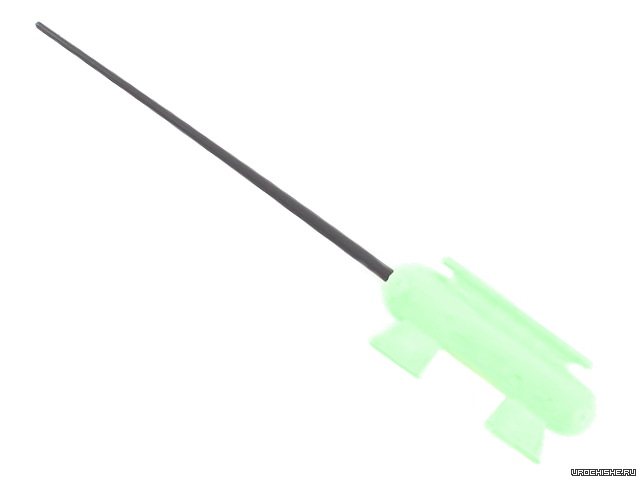
" Filly ". The simplest, “budget” option.
Which is unlikely to work
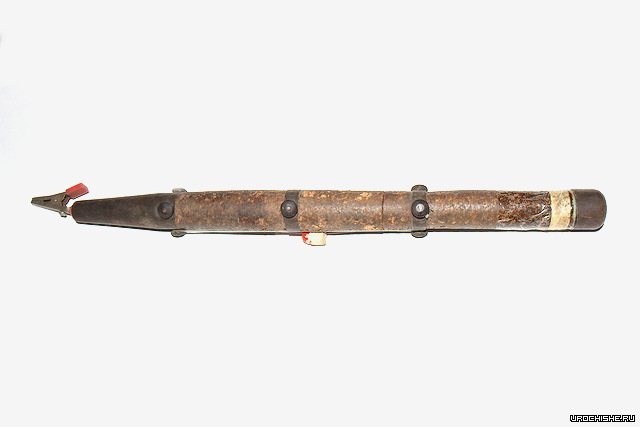
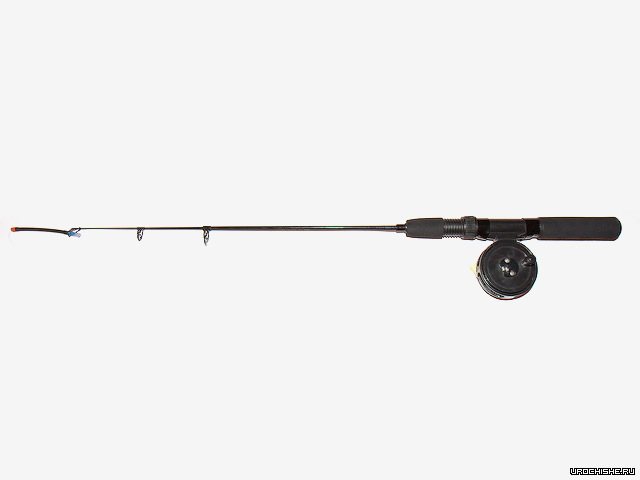
" Under-ice spinning ". It will be easier than the Uralka, but it is better to use it for fishing with a balance beam. Or a giant, heavy “devil” (there are such things).
Whip
The ideal option is carbon fiber (light and durable), you can use fiberglass or textolite. The average one is made of good, flexible and unbreakable plastic. The worst option is cheap plastic, which breaks under the slightest load.
Checking the whip is not difficult. To do this, you need to bend it with your hands so that the ends are relative to each other at an angle of 90°. And see how the whip “feels” at the same time. If it's not broken, it'll be fine. And if he is able to bend further, even better.
Nod
The most important part of the gear for catching devils. The nod provides the necessary play and signals a bite. The best material for it is lavsan. The best in the sense that it is the easiest to process and, at the same time, is not afraid of low temperatures (does not harden in the cold, at least at -10° C).
Like any other “guard” for a reelless fish, its elasticity should smoothly decrease from the rear end (which is articulated with the whip) to the front (from which the fishing line hangs). To ensure this characteristic, the nod is made conical , or rather trapezoidal, with a wide base at the whip, and a narrow base at the opposite end. This is achieved by cutting the material at the correct angle (a little lower I will tell you the exact parameters in millimeters).
However, taper is not the limit in improving the nod; nothing prevents us from making it double-cone (which will only have a positive effect on the performance of the bait and sensitivity). In this case, along the length of the nod from the rear end to the front, in addition to the width, the thickness also decreases. This is achieved by grinding down the lavsan with sandpaper.
Among devil catchers, not everyone makes nods from polymers; some experts do not recognize anything other than a clock spring, moreover, independently modified with a needle file to a double cone. I will say this - there is a grain of truth in this approach, because these specialists catch like animals. But in my opinion, lavsan and similar plastics are more modern materials, and they are the future.
The parameters of the nod (its length, width and thickness) directly depend on the mass of the bait, and at the moment when it is in the water, and, accordingly, it weighs less. Under the weight of the “devil,” the nod always bends downwards. This will by no means contribute to a slow, smooth game (but for energetic sharp shaking - just right), so we will have to bend the nod upward, so that with the bait hanging on its end, it tends as much as possible to a straight line (at least two-thirds of it length). This, by the way, provides additional sensitivity, for example, for those moments when the fish does not pull the “devil” down, but lifts it up.
How can one determine the exact parameters of a piece of lavsan? The most advanced method is the selection method. To do this, you need to make several nods of different lengths, and among them choose the one that bends 30-40 degrees to the horizon under the weight of the bait. Subsequently, at this angle, the nod can be bent in the opposite direction, and thus “straighten” it under the weight of the bait.
So, for a small lead “devil” weighing 0.75 - 1 gram, we got a nod with the following characteristics: length - 15 cm, width at the base - 6 mm, width at the tip - 1 mm, thickness (along the entire length) - 0.1 mm. The tackle was tested on ice and showed excellent results. Even with all its “one-taper” nature.
fishing line
The most popular option is monofilament with a thickness of 0.1 mm. It is possible to use fluorocarbon - the sensitivity to bite increases noticeably (mainly due to the fact that any poke from the fish is immediately transmitted to the hand). True, the game becomes somewhat less smooth, but - as practice has shown - this does not affect the overall catchability of the gear.
For small “devils”, the weight of which in lead does not exceed half a gram, you can use thinner fishing lines, since the size of the fish that bites the bait will be appropriate. For large “devils” - more than a gram, on the contrary - it makes sense to take a thicker fishing line, because the hour is uneven - it can take a good trophy.
It should also be taken into account that in the dead of winter, the thickness of the fishing line (as well as the weight of the bait) should be deliberately reduced so as not to once again alert the fish, which has become extremely suspicious.
Finally, we got to the main thing - to the “devil”.
Fishing for "devil" in the spring
A harsh winter has passed with serious unpleasant consequences for fish in the form of a lack of light and oxygen in the required quantities and a sad almost complete lack of bite for the fisherman.
Here comes the sound of drops, bright days are replaced by drizzling rains rustling through the March snow. It smells of piercing spring freshness, which makes you both anxious and joyful. The sky is already high and the clouds in it are no longer winter, heavy and frowning, but similar to a light suspension. Fresh water poured under the winter ice, from which the sleepy fish perked up, became gambling and greedy. It's time for a wide variety of fishing. And now the large mothless moths, which rather scare away fish in winter, have become a food item for them.
Spring fishing for “devil” can be very successful, and in combination with spring smells, sounds and landscapes it is also beautiful, which is also important for a real fisherman. And this is a time of sometimes dramatic changes, when many of the inclinations of capricious fish, established during winter, change. Sometimes such changes can fail a jig fisherman who took with him on spring fishing only traditional jigs for attaching bloodworms or some other bait. One day this would happen to me too, since all winter I caught different-sized roaches in the same place and only with bait. But I always have rewinders in stock. And one spring morning I didn’t see a single roach bite on bloodworms, while the black and red devils took quite well.
How to pick a devil for bream
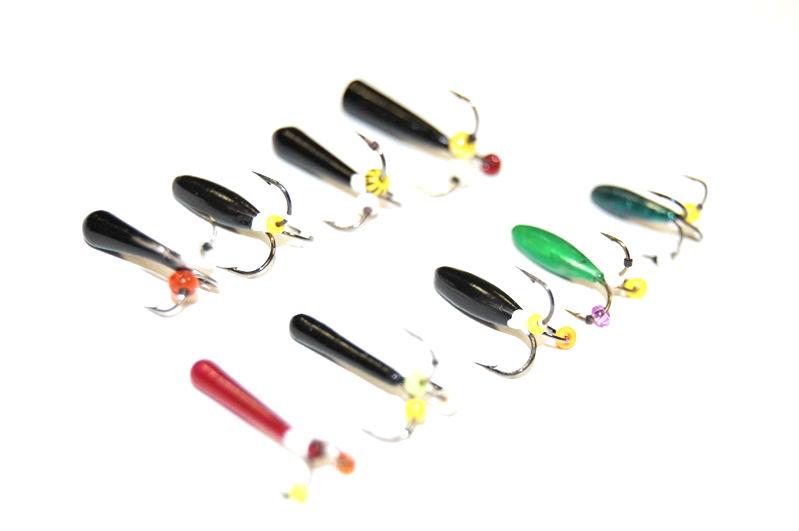
The devil is an effective jig that is most catchy when ice hunting. The bait is capable of awakening both the food reflex and banal curiosity in underwater inhabitants, forcing a passive or well-fed bream to grab a tasty object.
Not every trait is equally productive. There are models that are not able to interest underwater inhabitants. The bream can only poke and butt the bait, but it will be impossible to detect it. There are jigs that encourage fish to immediately attack them, confidently sitting on the hook.
Shape and color of the trait
The result of fishing depends on the correctly chosen shape of the jig and its color. The catchy devil for bream has an elongated body that slightly widens downwards. Round short modifications almost do not work, except for small underbream, silver bream and roach.
Note! Experienced fishermen keep curved models or devils with free-hanging hooks in their ammunition.
The color of the jig must be approached carefully. The most versatile and catchy little devils are black in color, possibly with white and yellow dots or stripes. In good lighting, matte shades such as copper are used. In cloudy weather, “silver” and “gold” work.
Lure sizes
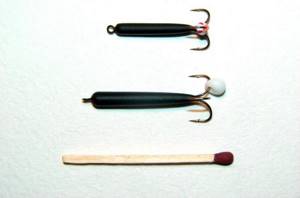
However, there is no point in using bait less than 1 cm long. The weight of the jig depends on the following factors:
- depth at the fishing site;
- presence and strength of current;
- horizon of fish parking;
- the gear used.
Since bream in most cases is caught at depths of 5 meters, the weight of the devil is selected from 0.8 grams. It happens that you have to use bait weighing 3–4 grams.
We recommend reading: Taimen fish, description

